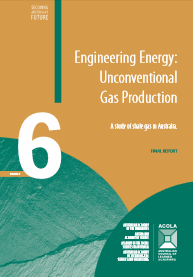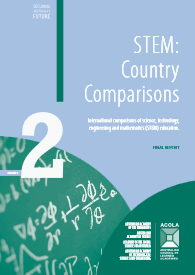|
|
|
|
|
|
|
News & Views item - June 2013 |
![]() PMSEIC's 2nd Meeting for 2013 Held on June 21. (June 27, 2013)
PMSEIC's 2nd Meeting for 2013 Held on June 21. (June 27, 2013)
The communiqué from the 2nd meeting of the Prime Minister's Science Engineering and Innovation Council is dated 25 June 2013. It is reprinted in full and is accompanied by four attachments, i.e. the full reports and listing of recommendations regarding "unconventional gas production" (hydraulic fracturing), and the "skills policy agenda to lift overall levels of numeracy, science and digital literacy (science, technology, engineering and mathematics", STEM).
In current circumstances the likelihood of these reports and their recommendations being received with any interest let alone proactively is at best negligible.
The 27th meeting of the Prime Minister’s Science Engineering and Innovation Council (PMSEIC) was held on 21 June in Sydney where members gathered for their second meeting of 2013.
The meeting heard a progress report from the Chief Scientist about his National Science, Technology, Engineering and Mathematics (STEM) Strategy.
Also tabled were two final project reports – Engineering Energy: Unconventional Gas Production and STEM: Country Comparisons.
These reports were produced as part of the Securing Australia’s Future program, undertaken on behalf of PMSEIC by the Australian Council of Learned Academies.
The meeting received recommendations developed from the findings contained in these two final project reports.
These recommendations were developed by the Office of the Chief Scientist in consultation with relevant government departments and the expert working groups responsible for the reports.
Relevant departments will respond to the recommendations with an action plan at the next PMSEIC meeting.
The meeting also received a report from the Office of the Chief Scientist – The Threat of Antibiotic Resistance: Building a New Frontline Defence which will be released as an Occasional Paper shortly.
Prior to the meeting, the Strategic Research Priorities to address the societal challenges facing Australia were released by the Prime Minister, Minister for Tertiary Education, Skills, Science and Research, Minister for Science and Research and the Chief Scientist.
The priorities will ensure that Government support for research is adequate in areas that are of immediate and critical importance to Australia and its place in the world.
PMSEIC will reconvene later in the year.
______________________________________________
The full ACOLA report, Engineering Energy:
Unconventional Gas Production![]()
Recommendations from the findings of the ACOLA report
STEM: Country Comparisons![]()
The
full ACOLA report STEM: Country Comparisons![]()
______________________________________________
Below we summarise the reports' recommendations
Engineering Energy: Unconventional Gas Production
Support the scientific, economic and social
research required to facilitate the safe and sustainable development of a
new source of natural gas and oil (i.e. from deep shale); including that
needed to build social acceptance and effective management regimes and
regulatory frameworks.
a. Encourage the development of an
industry-wide code
of practice for the exploration, production, and impact management of
natural gas production from shale. This should include a comprehensive
framework for data management, sharing, and communication.
b. Identify the necessary baseline data (geological, hydrological,
environmental) to be collected, prior to commencement of exploration and
production projects, against which project impacts can be fully and
effectively evaluated. Data collection methods must be transparent and the
data made publicly available.
c. Identify the parameters and frequency of measurement required to
implement an effective industry environmental monitoring regime for the
project life-cycle. Monitoring should include, but not be limited to,
surface and groundwater quality, greenhouse gas emissions, and seismicity.
Independent auditing or some other means of ensuring community confidence
will be required.
a. Assess publicly available data, and
identify and negotiate access to industry held data to identify
knowledge gaps, particularly with respect to estimating economic reserves.
b. Support research into the geological and geophysical aspects of
prospective sedimentary basins; particularly basin structure, stress field
and lithological characteristics to refine resource exploration models.
c. Support research into the surface and groundwater dynamics of prospective
sedimentary basins to better understand the likely impact on water resources
from exploration, production and upstream-industry requirements.
d. Implement policy to facilitate public access to geological, geophysical,
and environmental data collected during exploration drilling and geophysical
surveys.
e. Identify a suitable agency to act as data custodian and support the
development of a data base architecture for data storage and dissemination
and sample curation that will permit researchers and policymakers to address
multidisciplinary questions.
Through relevant frameworks (e.g. Commonwealth and Council of Australian Governments) build an efficient, transparent and effective regulatory system to achieve a resilient “compact” between the industry and communities.
_________________________________

STEM: Country Comparisons: Recommendations
The objectives of the following recommendations
are to:
1. Make sure that students in primary school spend sufficient time on science
and mathematics.
2. Lift the quality of STEM teaching at all levels of schooling to ensure
students understand and are inspired by science and mathematics.
3. Ensure useful, meaningful and high-quality resources are easily accessible to
support STEM teaching and learning at all levels of schooling.
4. Increase the number of students studying STEM disciplines to the end of Year
12 and in tertiary education.
5. Understand the demand for STEM skills in the workforce so that we can develop
strategies to get the right skills in the right place at the right time.
Implementation of these objectives and the following recommendations will
require consultation across multiple jurisdictional boundaries.
_______________________________
The Australian Government needs to:
Analyse and
evaluate cross-portfolio and cross government STEM education initiatives
1.1 Implement a stocktake and evaluation of innovative domestic STEM
education initiatives, highlighting duplication, opportunities for
coordination and gaps at all three levels of education.
1.2 Compare and contrast Australian pre- and in-service education and
resources for STEM teachers with countries that perform highly in STEM.
1.3 Coordinate and communicate findings to the STEM Reference Panel.
______________
I. Grow the
pool of STEM informed people in the Australian community
II. Increase the quantity and improve the quality of the STEM cohort in
higher education
2.1 Subject choices are reduced in Year 12, and STEM subjects made
compulsory.
2.2 Science teaching time in primary school should be increased from an
average of less than three per cent to closer to the European average.
2.3 High standards are expected from all students by building resilience and
confidence in solving maths problems through effective primary school
curricula and remedial programs in mathematics.
2.4 New and innovative strategies are established to grow the proportion of
women, indigenous and low SES and disadvantaged students in STEM education
and occupations.
2.5 Performance in numeracy and science is measured via the National
Assessment Program (including reporting of assessments against minimum,
proficient and advanced standards) as wellas international assessments such
as PISA and TIMSS to identify areas for improvement and track progress
toward the goal of being in the top five countries internationally in
mathematics and science by 2025.
2.6 An agreed target is established (across the industry, education and
government sectors) and associated incentives introduced for an increased
percentage of students in both secondary and tertiary STEM education in
Australia.
2.7 Significant prestigious STEM-focused schools and VET Centres of
Excellence are established and formal linkages between schools, VET and
Higher Education developed to encourage STEM.
2.8 STEM prerequisite requirements are re-introduced for relevant university
programs.
2.9 Strategies are developed and implemented for reducing attrition rates
across higher education STEM courses such as Engineering, ICT, Mathematics
and Sciences - especially where they are higher than average.
____________
Improve
STEM education and awareness through development, streamlining and
implementation of better teacher training and resources
3.1 Requirements and incentives are implemented for STEM teachers at both
junior and senior secondary levels to support implementation of both the
Australian Professional Standards for Teachers and the Accreditation of
Initial Teacher Education Programs: Standards and Procedures in Australia.
3.2 The quality of, and access to, professional development and performance
feedback, is improved through supporting the adoption of the Australian
Teacher Performance and Development Framework and the Charter for
Professional Learning of Teachers and School Leaders in Australia.
3.3 Career progression requirements and incentives for continuous
(discipline and pedagogy) professional development for teachers is
implemented in school and tertiary educational institutions.
3.4 A national program is developed to train specialist mathematics and
science teachers to teach in all primary schools.
____________
Facilitate
a national approach to STEM teaching and learning that meet the needs of
Aboriginal and Torres Strait Islander students
4.1 Successful and new STEM activities are identified and implemented
through a national coalition approach involving school, VET, higher
education, and business.
4.2 Culturally responsive resources and teacher professional learning
support are developed.
____________
Identify
the skill base that employers require from STEM graduates in the workforce
now and in the future
5.1 Introduce a process by which the skills required of STEM graduates (from
VET and higher education) in the labour force is identified through
consultation and surveys.
5.2 In partnership with industry, compare and contrast the current and
projected future requirements of STEM skills in the workforce with current
workforce arrangements and forecast STEM skills through the education
pipeline.
5.3 In partnership with industry, develop and implement a comprehensive Work
Integrated Learning Policy. It will ensure that students complete
work-related projects or placements throughout higher education. At least 50
per cent of STEM undergraduate students should complete a work-related
placement or project during their course.
____________
Develop a
STEM Reference Panel reporting to the relevant Federal portfolio ministers,
through the Chief Scientist, to report on STEM provision and participation
in Australia -- National coordination will make a significant contribution
to the enhancement of STEM education, participation, relevance and
performance in Australia - as it has been shown to do in many other
countries.
The STEM Reference Panel will undertake the following activities:
Identify and compile data and potential gaps concerning
participation and performance in STEM education (e.g. teacher workforce
data) and report annually where appropriate.
Prioritise factors contributing to the lack of STEM
Skills in Australia, their dependencies and their interrelationships.
Develop targets, an action plan, an evaluation frame
work, and communications strategy to address these priorities.
Coordinate and network policies and programs designed to
enhance approaches to STEM teaching and participation.
Enhance students’ knowledge about STEM jobs and
professions.
Develop an interdepartmental and intergovernmental STEM education committee across DEEWR, DIISRTE, and State Education Departments.